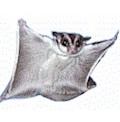The Sugar Glider (Petaurus breviceps) is a small marsupial originally native to eastern and northern mainland Australia, New Guinea, and the Bismarck Archipelago, and introduced to Tasmania. The Sugar Glider is around 16 to 21 cm (6.3 to 7.5 inches) in length, with a tail almost as long as the body and almost as thick as a human thumb, and weighs between 90 and 150 grams (3 to 5.3 oz). The fur is generally pearl gray, with black and cream patches on the underbelly and black or gray ears. Other color variations include leucistic and albino recessive traits. The tail tapers only moderately and the last quarter of it is black, often with a dark tip. The muzzle is short and rounded. Northern forms tend to be brown colored rather than gray and, as predicted by Bergmann's Rule, smaller.
The most distinctive features of its anatomy are the twin skin membranes called patagia, which extend from the fifth finger of the forelimb back to the first toe of the hind foot. These are inconspicuous when the Sugar Glider is at rest – it merely looks a little flabby – but immediately obvious when it takes flight. The membranes are used to glide between trees: when fully extended they form an aerodynamic surface the size of a large handkerchief. Membranes are also used to gather food while hunting. The membrane has a thin sheet of fur surrounding it, but it is usually pink in color.
In the wilds of its native habitat, the Sugar Glider is a tree dwelling creature, often living in groups of 15 to 30 (seven adults and their young). It is active by night when it hunts for insects and small vertebrates and feeds on the sweet sap of certain species of eucalyptus, acacia and gum trees. The Sugar Glider is named for its preference for sweet foods and its ability to glide through the air like a flying squirrel.
The Sugar Glider can occupy any area where there are tree hollows for shelter and sufficient food. Its diet varies considerably with both geography and the changing seasons, but the main items are the sap of acacias and certain Eucalyptus, nectar, pollen, and arthropods. It is difficult to see in the wild, being small, wary, and nocturnal, but a sure sign of its presence is the stripping of bark and tooth marks left in the soft, green shoots of acacia trees.
Where legal, the Sugar Glider is not difficult to breed in captivity under the right conditions, and small numbers have been legally and illegally exported to America where they have formed a breeding population for sale as pets. The Sugar Glider is a popular pet because of its lively and inquisitive nature. With plenty of attention, it bonds well to human companions. Sugar Gliders bred and kept in captivity behave differently than those in the wild.
